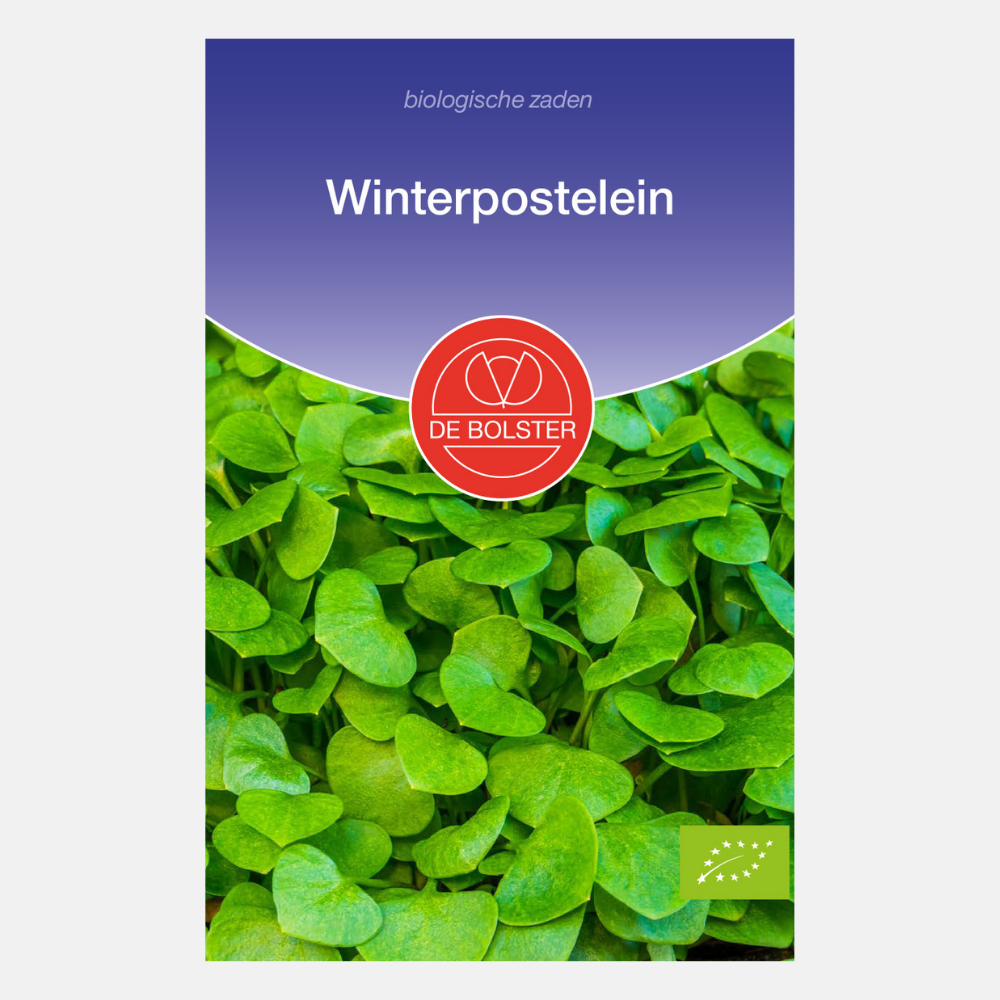Winter purslane BIO
Winter purslane is used in salads, as a raw vegetable or stew. In dry frost the colour of the leaves can become less beautiful. This is a winter-hardy type and has few problems with pests and diseases. One bag is for approximately 6m2, and the planting distance is 20x1 cm.
Winter purslane has few problems with diseases and pests. This type is winter hardy, only in dry frost the colour of the leaves becomes less beautiful and covering is desirable. Sow in August and September. If the soil temperature is still too high, winter purslane germinates very slowly. So don't think too quickly that it won't work out. You can also pre-sow winter purslane in August and September, and plant in September and October. Pre-sowing earlier usually does not result in an earlier harvest due to the slow germination at high temperatures. Fertilise very lightly. The seeds are small, by mixing the seeds with fine sand it is easier to sow sufficiently spaciously. If a sowing machine is used, mixing with sugar is a good method. Sow very shallowly (1-2 mm). Maintain a row distance of 20 to 25 cm. Do not sow too close together in the row! Keep the seedbed moist after sowing. Harvesting can be done from October (when sowing in August) to March (also in the winter months), by cutting the stems about 5 cm above ground level. The plant will sprout again and can yield a second and sometimes third cut. When growing in the open ground, it is wise to cover the plants during severe frost. In the spring, winter purslane first produces small white flowers, and can then go to seed very quickly. Remove the plants in time if you do not want the plant to sow itself en masse. Winter purslane can be used in salads, in raw vegetables or stews. TIP: also suitable as baby leaf (sowing period: August and September)!
- Biologisch
- Yes
- Merk
- The Bolster
- Type en soort
- Open-pollinated variety
- Standplaats
- Sun Partial shade
- Zaaien
- August September
- Planttijd
- September October
- Rijafstand
- 20 cm
- Plantafstand
- 1 cm
- Hoogte
- 30 cm
- Inhoud
- Approx. 10,000 seeds
Winter purslane BIO is backordered and will ship as soon as it is back in stock.
Couldn't load pickup availability
Dispatch
Dispatch
We ship your order within 1-2 business days*. When you spend €75,- you get one free shipment. Shipping is possible from €3.95. All orders are shipped as a package with a track and trace code, so you can always follow your order. Read more about the shipping costs in our FAQ.
Delivery time pre-order
Your order will be shipped from the indicated availability date. This also applies if you combine pre-order with products that are already in stock.
*Please note: In some cases this is not the case, such as: pre-orders, chicory roots, trees and small fruit. Read more in our FAQ.
The Bolster
The Bolster
Pioneer in organic seeds
De Bolster has been the specialist in 100% organic seeds for 45 years, with a focus on sustainability and future-proof agriculture. They produce seeds of more than 330 varieties, from vegetables and flowers to green manures, at international locations and completely GMO-free. With organic breeding methods and a commitment to variety freedom, they work together with professional growers and hobby gardeners to make organic cultivation accessible to everyone. Since 2023, they have been operating as a cooperative, to increase the impact of organic farming together with customers and suppliers. Their dream? A healthy planet with 100% organic farming.
Explanation of resistances
Explanation of resistances
Our seeds are provided with different resistance codes. In this PDF you will find a clear explanation of all codes and their meaning.
Different types of seeds
Different types of seeds
What is the difference between organic, F1 hybrid, heirloom (open-pollinated), GMO, pill and conventional seeds? We explain it to you in this blog !
Saving seeds
Saving seeds
Store seeds in a cool, dry and dark place, such as a sealed box in a cupboard. Pay attention to the expiration date on the packaging and use them before that time. If the packaging has been opened, make sure it is sealed properly and check the germination capacity before use.
You can easily test the germination capacity of seeds with a germination test :
- Place a few seeds (for example 10) on a damp piece of kitchen paper.
- Fold the paper towel closed and place it in a plastic bag or place it in a sealed container.
- Place it in a warm place, such as on the windowsill.
- After a few days, check to see if the seeds have started to germinate.
Basic sowing guide
Basic sowing guide
First time sowing? No problem! Our basic sowing guide will briefly explain how to get started. Also take a look at our extensive growing guides for specific tips per plant species - super handy if you want to know exactly how to grow aubergine or garlic, for example 🌱.








